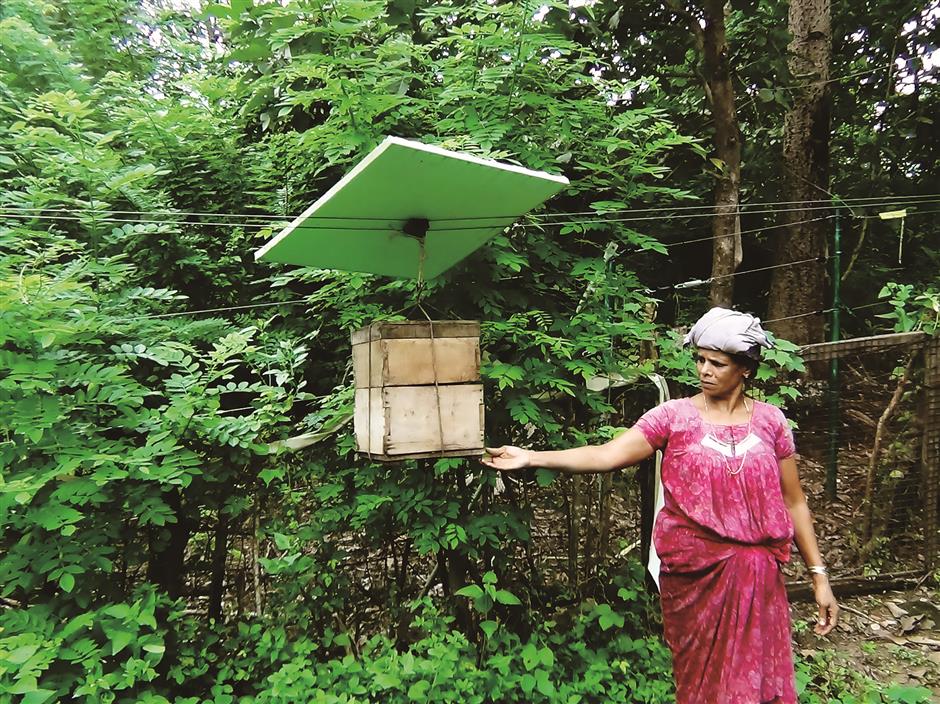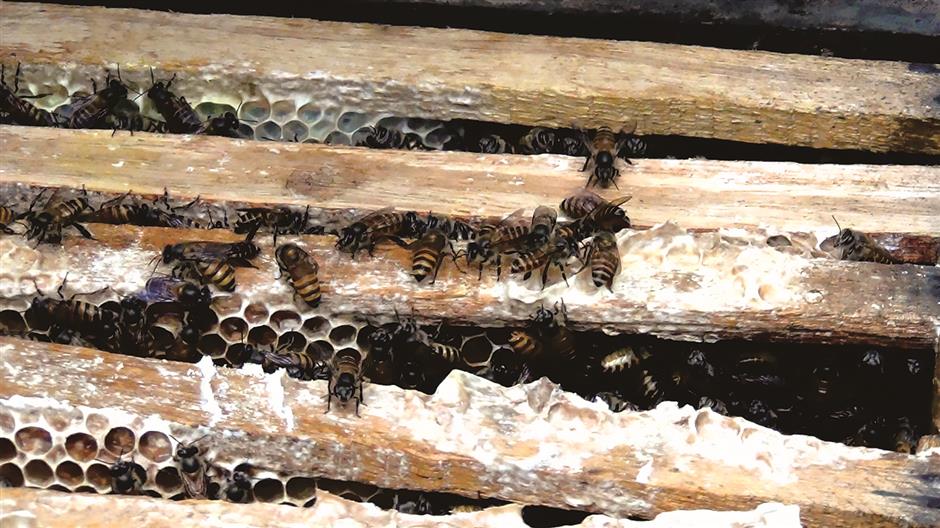India fights marauding elephants, saves people and crops with a fence of beehives

A farmer displays a beehive that is part of an elephant control beehive fence in Mayilattumpara village in India.
A year ago, no one in Mayilattumpara could sleep soundly at night. Residents of the village in the foothills of Thrissur district, in southwest India’s Kerala state, feared invasions by wild elephants.
The animals, reacting to the loss of their forest habitat and a scarcity of food, frequently invaded the farms around the village, trampling on plants and crops and destroying incomes.
Everything the villagers tried to deter the animals — digging trenches, beating drums, installing solar-powered electric fences, or planting shrubs with supposed repellent qualities — proved ineffective. One after another, residents began to give up farming. But they finally found a solution — honey bees.
A wire fence strung with beehives now stretches 2.5 kilometers over 18 village farms. The hives hang every 10 meters.
Elephants, it turns out, are frightened of loudly buzzing bees and their ferocious stings. When elephants try to pass the wire fence, angry bees swarm out and the elephants run away.
Protected by the bees, farmers can tend their crops again. And some are also beginning to cultivate a new harvest — honey.
Johny Kochery has 9 hectares in Mayilattumpara, but for a time he gave up trying to produce crops after repeated damage by elephants. Now he points to flourishing coconut trees, rubber plants and more than 60 varieties of fruit on his land.
Since installing the beehive fence a year ago, “not even a single elephant reached the vicinity of my farm. Elephant attacks are an old story,” he said.
During the recent monsoon, elephant herds crossed the nearby Peechi reservoir and raided the neighboring villages of Kalladik, Thekkumpadu and Poolachode, trampling plantain trees and destroying villagers’ huts.
But they haven’t come any closer than 100 meters to the beehive fence protecting Mayilattumpara, residents said.

A view of bees inside a beehive in Mayilattumpara village in India's Kerala state
The fence project, begun in January 2016 by local farmers with the support of the federal government’s Agriculture Technology Management Agency cost 500,000 Indian rupees (US$7,800).
V.S. Roy, who initiated the project while working for ATMA, said the idea came from the work of Lucy King, an Oxford University researcher who in 2008 successfully tested using African honeybees to keep elephants at bay in areas of Kenya where there was conflict between the animals and people.
“If it could (work) in the African forest, why couldn’t it in the Kerala forest?” Roy remembered thinking.
According to India’s environment ministry, conflict between humans and elephants across the country leads to regular deaths among both.
In Kerala alone in 2017, 22 people died in conflicts with elephants.
Last year the state’s forest department paid more than 90 million rupees in compensation for loss of life and destruction of property caused by elephants, officials said.
Roy’s project was not an initial success. An experiment in 2012, in another district, failed in part because he did not first get sufficient support from local people, he said.
When he came to Mayilattumpara, he started the farmers’ association and involved them in the planning to win their backing and participation.
Kochery, who heads the farmers’ association, noted that setting up such a system is not easy.
Besides figuring out an effective fence and hive system, farmers also had to learn to manage bees and replace colonies that become diseased.
But today the effort is beginning to pay off. Each December to March honey season, each of the 260 beehives strung along the fence could produce as much as 30 kilograms of honey.
This has the potential to bring in up to 65,000 rupees for each farmer.
But Kochery said the farmers only broke even last season due to some initial glitches — but they hope to have a big harvest this year.
Despite the challenges, farmers from other areas of human-elephant conflict in the state now hope to replicate the Mayilattumpara effort and win financial support from the state’s Forest and Wildlife Department.
E.A. Jayson, a scientist with the Kerala Forest Research Institute, which has completed a study of the beehive fence experiment, said the fencing seems to work. But there are now new problems to solve.
“Rather than technical issues, some social issues are creating hindrances. We have met with incidences of theft of beehive boxes,” Jayson said.
















